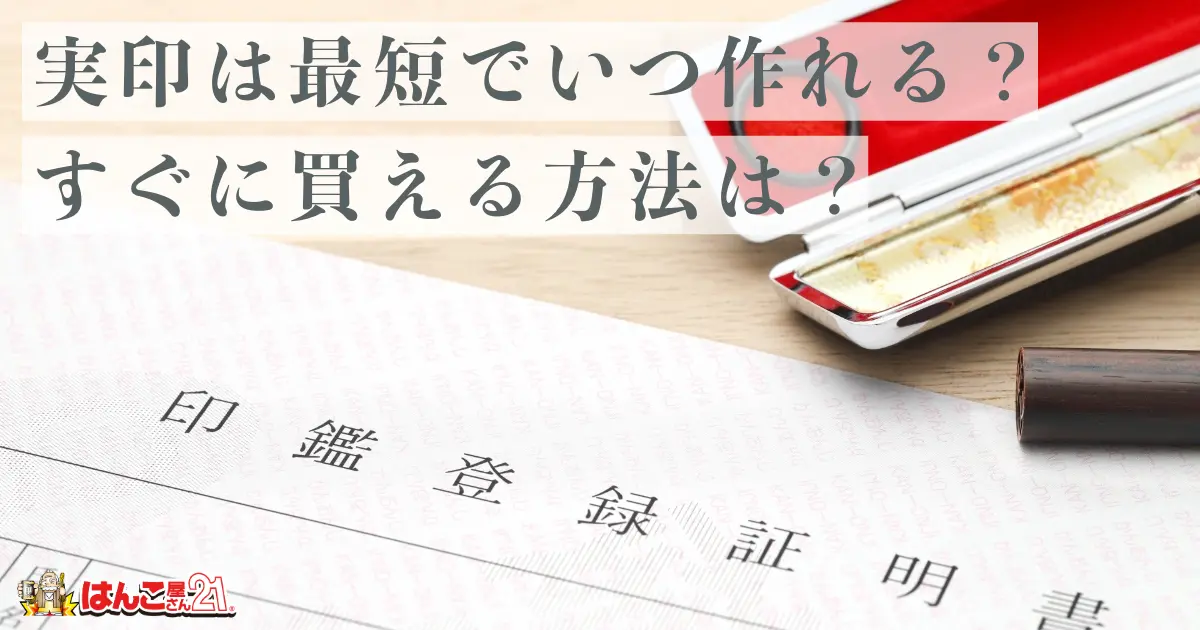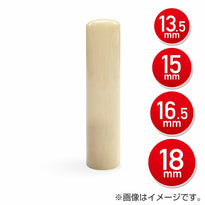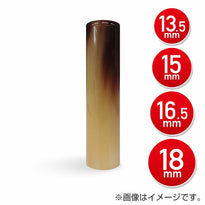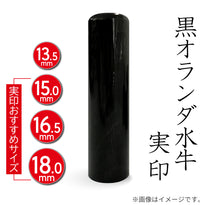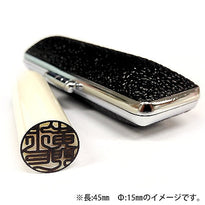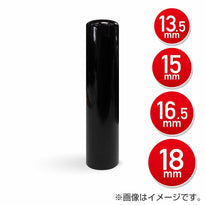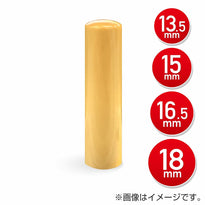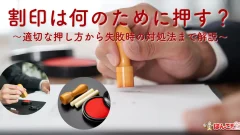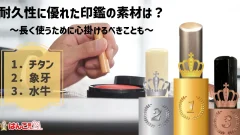A personal seal is used on important contracts, but some people may not have one because they don't have many opportunities to use it. It can be a hassle if you are suddenly told you need a personal seal at a time like that. In this article, we will explain how to buy a personal seal quickly for those who want to make one quickly.
Required procedures and time required to create a registered seal
What is a registered seal?
Even if you know the word "jitsuin," if you don't have a clear HANKO of what role it plays, you probably won't even think about making one. First, let's get to know what a jitsuin is.
To understand jitsuin, it is necessary to know the correct meaning of HANKO(stamp). We say "please stamp your seal" or "please stamp HANKO," but strictly speaking, the actual seal itself is called an "insho" (seal).
When a seal is filled with vermilion and pressed onto paper, the mark that remains as text is called an "impression." The impression that is submitted by stamping an application form at a local government office is called a "HANKO."
The word "inkan" is said to have originated from the fact that the register used to check the seal impression to verify that the seal was genuine was called a "HANKO."
Currently, if you report your personal seal to the city hall where you are registered and register the "seal impression," that seal becomes a "jitsuin." Incidentally, a seal that you register when opening an account at a bank or other financial institution becomes a "ginkoin."
What is HANKO registration?
You can only call a seal a "jitsuin" (official HANKO) if you have registered the seal with the local government, such as your city, ward, town, or village office. Even if a seal is sold as a "jitsuin" at a HANKO specialty store, it will not become a jitsuin unless HANKO register it.
By law, anyone over the age of 15 can register their own HANKO of their own volition. Take the HANKO(hanko) you will use as your official seal and identification (driver's license, passport, My Number card, etc.) to the city hall where you live, fill out an application form, and submit it. If you do not have identification, you can apply at the city hall together with your guarantor by bringing two documents such as your health insurance card and pension book, the guarantor's official seal, and the guarantor's HANKO registration certificate.
However, please note that there are regulations regarding which HANKO(hanko) can be registered as official HANKO. Although it depends on the local government, the size of the seal impression is basically stipulated as "not to fit into an 8mm square, and not to extend beyond a 25mm square." In other words, if the seal impression fits into a square with one side of 8mm, it is too small, and if it extends beyond a square of 25mm, it is too large and cannot be registered.
An individual can only register one official seal. In addition to an individual registering multiple official seals, couples and parents and children cannot register the same HANKO. In addition, a "HANKO registration certificate" is generally obtained and used in conjunction with the official seal.
When to use a real seal
When used in conjunction with a HANKO registration certificate, a registered seal proves that the seal was made with the "person's will." In order to exert a stronger social impact, it is primarily used in the following situations:
Buying and selling cars
When purchasing a regular car, you will need a registered seal to register the new car with the Ministry of Land, Infrastructure, Transport and Tourism. If you take out a loan, you do not need a registered seal because the dealer or loan company has ownership of the car. Also, when purchasing a light vehicle, you do not need a registered seal because you do not need to register it with the Ministry of Land, Infrastructure, Transport and Tourism. On the other hand, when buying and selling a used car privately, you will need a registered seal to apply for transfer registration in order to change the owner's name.
Real estate transactions
When buying or selling a condominium or detached house, the Legal Affairs Bureau will verify the owner's official seal to verify the ownership and to process the transfer of registration.
Loan contract/bank financing
A registered seal and HANKO certificate are required when a financial institution performs identity verification for a loan contract such as for buying and selling real estate, or when obtaining a loan from a financial institution using real estate as collateral.
Other uses include using a personal seal to certify the articles of incorporation when establishing a company, and stamping notarized documents for inheritance or divorce, and in other important situations.
When should I make a seal?
The timing of when to make a jitsuin varies from person to person. If you make one out of necessity, you may end up in a hurry and not be able to get a jitsuin that satisfies your needs. There are also cases where you may want to make a jitsuin after a major event in your life, such as:
School Graduation
There are many cases where people create a registered seal after graduating from high school, university, vocational school, etc., and before joining the workforce. After getting a job and leaving their parents' home to become independent, there are more situations where they will need a registered seal, so it seems that parents may also give advice on this.
Coming of Age Ceremony
You can register your official seal from the age of 15, but generally speaking, you make your official seal when you reach adulthood as proof that you have become an adult. There are also cases where a HANKO to be used as an official seal is given as a gift on Coming of Age Day.
marriage
In particular, women often change their surnames when they get married, so it is better to create a personal seal with your new surname when you get engaged or get married to avoid having to do the work twice. Some women register HANKO with only their given name before they get married, but we recommend creating a personal seal with your full name to prevent forgery.
The time and cost required to make a seal
The time it takes to make a jitsuin varies depending on the HANKO maker you hire, the material, and the method of making. Generally, you should allow 3 to 4 days. Depending on the carving method, it may take longer.
The cost of making a HANKO varies depending on the material it is made of. A personal seal made of ivory, known as the "king of HANKO," is the most expensive, costing between 20,000 and 70,000 yen.
Like ivory, black buffalo horn, which is considered a suitable material for official seals, is priced at around 5,000 to 20,000 yen, while titanium, which has recently become popular, is priced at around 10,000 to 30,000 yen. Dutch buffalo horn, which is popular among women, is priced at around 7,000 to 25,000 yen, and natural rose quartz is priced at 15,000 to 24,000 yen, making it a very diverse material.
Risks and precautions when purchasing a personal seal at a 100 yen shop
A HANKO is a personal HANKO that is registered with a local government, but this does not mean that any seal can be registered. Some local governments have regulations regarding the size of the seal as well as the following:
About the durability and engraving of HANKO
HANKO that are likely to have distorted imprints may not be able to be registered. For example, rubber stamps such as name stamps, including Shachihata. This is because if the imprint of the registered HANKO and the imprint of the seal when it is subsequently stamped are distorted, it cannot be proven that they are the same. Also, seals that are missing or have no outline, or seal imprints that are unclear, may not be able to be registered.
Engraving contents
In principle, the content engraved on the seal is limited to the name on the family register. Only the family name, only the first name, or the full name, or a combination of initials are all recognized as official seals.
However, we will not accept engravings that are unrelated to the name on your legal name, such as an occupation name, title, illustrations or designs.
Typeface suitable for registered seals
There are no regulations regarding the typeface for a HANKO to be registered as a registered seal. However, since it is a HANKO used to prove one's identity for important contracts, etc., the risk of it being misused through forgery should be avoided. For this reason, it is common to choose a typeface for a registered seal that is difficult to forge.
Seal script is the style of writing that is also carved on the gold seal of the King of Na, which is said to be the oldest HANKO in Japan. It is a historic style of writing that is currently printed on paper money issued by the Bank of Japan. The characters are cursive, making them difficult to read, making them difficult to counterfeit. In addition, the characters are packed into the frame of the HANKO, making it highly durable and popular as a style suitable for official seals.
Inso-tai is also called Kisso-tai or Happo Tensho-tai. It is a style of calligraphy based on Tensho-tai. The unique characters of the HANKO are difficult to read, and the characters are characterized by touching the HANKO frame. Inso-tai is also a style of calligraphy often used for official seals.
Koin-tai is based on the HANKO used for seals at temples and shrines during the Nara period. It is used for official seals and bank seals, but because it is an easy-to-read typeface, it is also often used for personal seals.
Reisho-tai is said to be a straight-line style based on the seal script. It is a historical style, but is known as the easiest to read. It is a familiar style that is often used for personal seals.
The HANKO on display at 100-yen shops are so-called "sanmonban" stamps used as personal seals. Sanmonban stamps include HANKO engraved on plastic or wood, and stamp-type stamps such as Shachihata stamps. Rubber stamps generally cannot be registered as official seals because the surface of the stamp may be deformed. However, other sanmonban stamps can be used as official seals.
Since they are intended to be used as personal seals, they are often written in familiar, easy-to-read koin or clerical script. Moreover, they are mass-produced and HANKO with the same seal face.
Registering a HANKO that anyone can get as a registered seal increases the risk of it being misused. It is preferable for the HANKO of the seal to be low-readability and difficult to forge, so if possible, we recommend seal script or seal impression typeface.
Also, even if you have a cheap stamp other than a name stamp, such as a Shachihata stamp, you should be aware that local governments may not accept your registration for reasons such as "the seal is easily deformed" or "it is easy to obtain and therefore not suitable as a real seal."
How to quickly purchase a seal
If you find yourself in a situation where you need to stamp a legal seal on a contract document, what are your options? Understanding the importance of legal seals, you want to avoid purchasing a cheap seal without thinking.
Generally speaking, if you ask a HANKO specialist to make a personal seal for you, the number of days it takes to complete the process will vary depending on the HANKO method used. If it is handmade by a craftsman, it will take 7 to 10 days, and if it is completely hand-carved, it will take about 8 to 12 days. If it is made of titanium, it will be made in a factory and will be completed in about 5 to 7 days.
If the item is carved by machine rather than by hand, it can be ordered and finished the next business day even if it is made of ivory or buffalo horn. The average time is about 3 days.
summary
If you need a HANKO to use as your official seal as soon as possible, consult with a HANKO specialist with a physical store. If you order at " Hanko Shop 21 " at a store, you can receive HANKO on the same day at the earliest, and on average the next business day. Since it is a physical store, you can consult with a HANKO specialist staff face-to-face and convey your request, and you can actually check the material and size.
Related products
Related article
 日本語
日本語 English
English 简体中文
简体中文 繁體中文
繁體中文 한국어
한국어 ไทย
ไทย Tiếng Việt
Tiếng Việt Indonesia
Indonesia Français
Français Español
Español Português
Português
